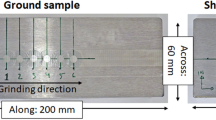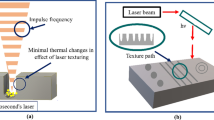Abstract
Short-pulsed lasers are of significant industrial relevance in laser drilling, with an acceptable compromise between accuracy and efficiency. However, an intensive research with regard to qualitative and quantitative characterization of the hole quality has rarely been reported. In the present study, a series of through holes were fabricated on a high-temperature alloy workpiece with a thickness of 3 mm using a LASERTEC 80 PowerDrill manufacturing system, which incorporated a Nd:YAG millisecond laser into a five-axis positioning platform. The quality of the holes manufactured under different laser powers (80–140 W) and beam expanding ratios (1–6) was characterized by a scanning electron microscope associated with an energy-dispersive X-ray analysis, focusing mainly on the formation of micro-crack and recast layer. Additionally, the conicity and circularity of the holes were quantitatively evaluated by the apparent radius, root-mean-square deviation, and maximum deviation, which were calculated based on the extraction of hole edge through programming with MATLAB. The results showed that an amount of melting and spattering contents were presented at the entrance end and the exit end of the holes, and micro-cracks and recast layer (average thickness 15–30 µm) were detected along the side wall of the holes. The elemental composition of the melting and spattering contents and the recast layer was similar, with an obvious increase in the contents of O, Nb, and Cr and a great reduction in the contents of Fe and Ni in comparison with the bulk material. Furthermore, the conicity and circularity evaluation of the holes indicated that a laser power of 100 W and a beam expanding ratio of 4 or 5 represented the typical optimal drilling parameters in this specific experimental situation. It is anticipated that the quantitative method developed in the present study can be applied for the evaluation of hole quality in laser drilling and other drilling conditions.










Similar content being viewed by others
References
W. Schulz, U. Eppelt, R. Poprawe, Review on laser drilling I. Fundamentals, modeling, and simulation. J. Laser Appl. 25, 012006 (2013)
A. Ancona, D. Nodop, J. Limpert, S. Nolte, A. Tunnermann, Microdrilling of metals with an inexpensive and compact ultra-short-pulse fiber amplified microchip laser. Appl. Phys. A 94, 19–24 (2009)
R.S. Bunker, A review of shaped hole turbine film cooling technology. J. Heat. Transf. 127, 441–453 (2005)
X.D. Wang, A. Michalowski, D. Walter, S. Sommer, M. Kraus, J.S. Liu, F. Dausinger, Laser drilling of stainless steel with nanosecond double-pulse. Opt. Laser Technol. 41, 148–153 (2009)
J.K.M. Garofano, H.L. Marcus, M. Aindow, Nanoscale carbide precipitation in the recast layer of a percussion laser-drilled superalloy. Scripta Mater. 61, 943–946 (2009)
H.K. Sezer, L. Li, M. Schmidt, A.J. Pinkerton, B. Anderson, P. Williams, Effect of beam angle on HAZ, recast and oxide layer characteristics in laser drilling of TBC nickel superalloys. Int. J. Mach. Tool Man. 46, 1972–1982 (2006)
X.Y. Wang, G.K.L. Ng, Z. Liu, L. Li, L. Bradley, EPMA microanalysis of recast layers produced during laser drilling of type 305 stainless steel. Thin Solid Films 453–454, 84–88 (2004)
B. Kang, G.W. Kim, M.Y. Yang, S.H. Cho, J.W. Park, A study on the effect of ultrasonic vibration in nanosecond laser machining. Opt. Laser Eng. 50, 1817–1822 (2012)
J.A. Porter, Y.A. Louhisalmi, J.A. Karjalainen, S. Fuger, Cutting thin sheet metal with a water jet guided laser using various cutting distances, feed speeds and angles of incidence. Int. J. Adv. Manuf. Technol. 33, 961–967 (2007)
J. Kaspar, A. Luft, S. Nolte, M. Will, E. Beyer, Laser helical drilling of silicon wafers with ns to fs pulses: scanning electron microscopy and transmission electron microscopy characterization of drilled through-holes. J. Laser. Appl. 18, 85–92 (2006)
K.H. Leitz, B. Redlingshofer, Y. Reg, A. Otto, M. Schmidt, Metal ablation with short and ultrashort laser pulses. Phys. Proced. 12, 230–238 (2011)
S. Juodkazis, H. Okuno, N. Kujime, S. Matsuo, H. Misawa, Hole drilling in stainless steel and silicon by femtosecond pulses at low pressure. Appl. Phys. A 79, 1555–1559 (2004)
H.Y. Zhang, J.K. Di, M. Zhou, Y. Yan, R. Wang, An investigation on the hole quality during picosecond laser helical drilling of stainless steel 304. Appl. Phys. A 119, 745–752 (2015)
H.Y. Zhang, J.K. Di, M. Zhou, Y. Yan, A comparison in laser precision drilling of stainless steel 304 with nanosecond and picosecond laser pulses. Chin. J. Mech. Eng. 27, 972–977 (2014)
S. Leigh, K. Sezer, L. Li, C. Grafton-Reed, M. Cuttell, Recast and oxide formation in laser-drilled acute holes in CMSX-4 nickel single-crystal superalloy. Proc. IMechE Part B J. Eng. Manuf. 224, 1005–1016 (2009)
V. González-Castro, J. Debayle, J.C. Pinoli, Color adaptive neighborhood mathematical morphology and its application to pixel-level classification. Pattern Recogn. Lett. 47, 50–62 (2014)
A. Barchanski, D. Funk, O. Wittich, C. Tegenkamp, B.N. Chichkov, C.L. Sajti, Picosecond laser fabrication of functional gold-antibody nanoconjugates for biomedical applications. J. Phys. Chem. C 119, 9524–9533 (2015)
K.H. Leitz, H. Koch, A. Otto, M. Schmidt, Numerical simulation of process dynamics during laser beam drilling with short pulses. Appl. Phys. A 106, 885–891 (2012)
S. Bandyopadhyay, J.K. Sarin Sundar, G. Sundararajan, S.V. Joshi, Geometrical features and metallurgical characteristics of Nd:YAG laser drilled holes in thick IN718 and Ti-6Al-4 V sheets. J. Mater. Process. Technol. 127, 83–95 (2002)
D.K.Y. Low, L. Li, A.G. Corfe, Characteristics of spatter formation under the effects of different laser parameters during laser drilling. J. Mater. Process. Technol. 118, 179–186 (2001)
W.T. Chien, S.C. Hou, Investigating the recast layer formed during the laser trepan drilling of Inconel 718 using the Taguchi method. Int. J. Adv. Manuf. Technol. 33, 308–316 (2007)
F. Dausinger, Femtosecond technology for precision manufacturing: fundamental and technical aspects. RIKEN Rev. 50, 77–82 (2003)
Acknowledgments
This study was supported by National Basic Research Program of China (Grant No. 2011CB013004), National Natural Science Foundation of China (Grant No. 51375008), Tsinghua University Initiative Scientific Research Program (Grant No. 20151080366), and the Research Fund of State Key Laboratory of Tribology, Tsinghua University, China (Grant No. SKLT2015B03).
Author information
Authors and Affiliations
Corresponding author
Rights and permissions
About this article
Cite this article
Zhang, H., Zhou, M., Wang, Y. et al. Development of a quantitative method for the characterization of hole quality during laser trepan drilling of high-temperature alloy. Appl. Phys. A 122, 74 (2016). https://doi.org/10.1007/s00339-016-9599-4
Received:
Accepted:
Published:
DOI: https://doi.org/10.1007/s00339-016-9599-4




